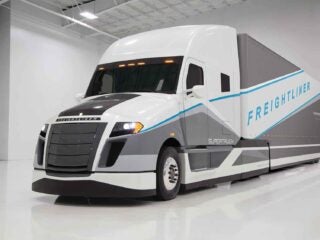- Resources
- Walmart and J.B. Hunt give glimpse of trucking’s future
Resources
Walmart and J.B. Hunt give glimpse of trucking’s future
Published: August 17, 2020 by Jason Mathers
It’s an everyday scene in Southern California: a big rig hauling a metal shipping container from a port facility to a distribution center or rail yard. Last week, this old story got a new twist with a 120-mile emission-free haul featuring two shipping behemoths from Northwest Arkansas: Walmart and J.B. Hunt.
Our nation’s two biggest marine ports — the Port of Los Angeles and the Port of Long Beach — operate right next door to each other in a complex known as the San Pedro ports. Nearly 40% of the shipping containers coming into the U.S. enter through this complex. These containers are packed with goods destined for homes and business across the country, with stops along the way at distribution centers, fulfillment centers and retail shelves.
The consumption and movement of these goods has profound equity implications. This is acutely the case around the San Pedro ports. A recent report found that “freight movement accounts for about 42% of NOx emissions in the South Coast Air Basin, with heavy-duty trucks that service the ports the single-largest source within that category.” These trucks, known as drayage trucks, are a mere 0.1% of the vehicles on the road but contribute 5% of total NOx pollution. Addressing the impact of drayage trucks is an environmental and equity imperative. Thankfully, we have the technical means to do so.

There are already a number of fleets operating zero-emission drayage trucks today, including models by Volvo and by Daimler. These trucks are preforming well and fleets want more of them. Recognizing the connection between EV technology and health benefits, the California Air Resources Board established a target of an all zero-emission drayage truck fleet by 2035.
Systemic barriers remain to moving the 17,000 drayage trucks operating in the San Pedro ports to zero-emission vehicles. Chief among these barriers is access to capital for drayage operators. Battery electric drayage trucks have a significantly lower total cost of ownership than either diesel trucks or natural gas trucks. The upfront cost for these trucks is higher, though. Many drayage operators are smaller entities that often purchase used trucks, in part because of their limited ability to get low-interest loans.
The J.B. Hunt and Walmart news is exciting in part because it highlights how large companies can accelerate the transition to zero-emission drayage trucks. J.B. Hunt and other large carriers that operate drayage fleets are uniquely well positioned to be first adopters of zero-emission trucks. Their leadership benefits smaller fleets by helping to establish the ecosystem necessary to support these trucks, which includes charging stations, dealer familiarity and maintenance support. J.B. Hunt also benefits by increasing their understanding of how to optimize performance of electric trucks — knowledge they can leverage in their dedicated fleets and other operations.
Walmart, as the top importer of shipping containers into the U.S., is likely also the top customer of drayage operators. It and other large cargo owners, including Target, Amazon and Nike, are well positioned to work with drayage fleets to accelerate the adoption of EVs. For example, these companies could collaborate to develop the charging infrastructure needed to support drayage delivery by EVs. They could also leverage their size and business savvy to help create financing solutions that enable drayage operators to access low-cost capital.
In partnering with drayage operators to move to zero-emission delivery, Walmart and other cargo owners would gain several benefits. Most critically, these companies would reduce the impact their operations have on the health of frontline communities. Additionally, Walmart and other companies would make a meaningful reduction in supply chain greenhouse gas emission. By increasing production capacity and product quality in ways that drive down costs, increase range and improve freight payload, the companies will also help drive forward the development of electric trucks.
This last benefit is key for cargo owners that also operate their own fleets, such as Walmart. Their investments to electrify drayage will pay dividends for their own fleet operations. Further advancements in electric truck performance will fast track the day when these trucks become a major segment of their own fleets. The public policies on fleet charging, vehicle incentives and other areas that first support a move to zero-emission drayage would serve as models for effective policies that advance electrification for longer-haul trucks. The end result is that these companies will be better prepared to quickly optimize the use of electric trucks within their own operations.
As this glimpse makes clear, zero-emission drayage is the future. How soon that future arrives is still uncertain, though. Carriers and cargo owners have key roles in this transition. By embracing a zero-emission future, these companies can accelerate its arrival and strengthen their own standing. Let this recent move be but the first of many, many more to come.
Follow Jason on Twitter.

